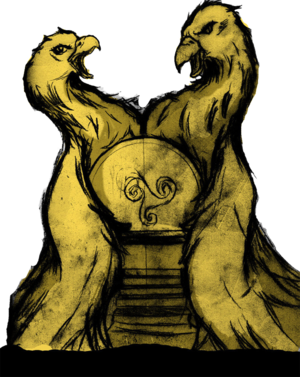Heavenly Eagle Throne: Difference between revisions
No edit summary |
No edit summary |
||
| (3 intermediate revisions by the same user not shown) | |||
| Line 1: | Line 1: | ||
[[File:Eagle throne.png|thumb|right|The Eagle Throne, made out of South Dalmacijan gold.]] | [[File:Eagle throne.png|thumb|right|The Eagle Throne, made out of South Dalmacijan gold.]] | ||
The '''Eagle Throne''' was the term used to identify the throne of the [[Caudillo]] of the [[Apollonian Republic]] and later became the symbol of the throne of the [[Jingdaoese Empire]]. The term also | The '''Eagle Throne''', in Jingdaoese possession ofter refered to as '''Heavenly Eagle Throne''', was the term used to identify the throne of the [[Caudillo]] of the [[Apollonian Republic]] since 1617 AN and later became the symbol of the throne of the [[Jingdaoese Empire]]. The term also refers to very specific seating, such as the throne which once stood in the throne hall of [[Marmore Palace]] (later moved to the [[Simonspaleis]] in [[Epoli]] and in 1641 AN to the Heavenly Palace in [[Daocheng]]). | ||
In a metonymic sense, the "Eagle Throne" also refers rhetorically to the head of state and the institution of the House of Myksos in its role as ruling dynasty itself. The throne itself was made at the request of [[Taodosius Myksos]], first Dutch of the Myksos household to rule Kildare. The throne itself eventually became a symbol of power over the whole Republic when it became clear that [[Trajan Myksos]] and his successors would proceed ruling even after the proclamation of the Republic. | In a metonymic sense, the "Eagle Throne" also refers rhetorically to the head of state and the institution of the House of Myksos in its role as ruling dynasty itself. The throne itself was made at the request of [[Taodosius Myksos]], first Dutch of the Myksos household to rule Kildare. The throne itself eventually became a symbol of power over the whole Republic when it became clear that [[Trajan Myksos]] and his successors would proceed ruling even after the proclamation of the Republic. | ||
In January 2016, with the democratisation of the Jingdaoese Empire (after a terrible nuclear destruction in its cities derailed the society), the Eagle Throne regained a certain status (as it had survived the nuclear disaster) and was used once more, but this time as throne of the Emperor of Jingdao (the first Emperor to use it was | In 1632 AN (January 2016), with the democratisation of the Jingdaoese Empire (after a terrible nuclear destruction in its cities derailed the society), the Eagle Throne regained a certain status (as it had survived the nuclear disaster) and was used once more, but this time as throne of the Emperor of Jingdao (the first Emperor to use it was the [[Zettai Emperor]]). The Throne remained a strong symbol of imperial dominance in all affairs and is well guarded within the [[Daocheng Palace|Imperial Palace of Daocheng]]. | ||
[[category:Apollonia]] | [[category:Apollonia]] | ||
[[category:Jingdao]] | |||
Latest revision as of 10:40, 7 April 2020
The Eagle Throne, in Jingdaoese possession ofter refered to as Heavenly Eagle Throne, was the term used to identify the throne of the Caudillo of the Apollonian Republic since 1617 AN and later became the symbol of the throne of the Jingdaoese Empire. The term also refers to very specific seating, such as the throne which once stood in the throne hall of Marmore Palace (later moved to the Simonspaleis in Epoli and in 1641 AN to the Heavenly Palace in Daocheng).
In a metonymic sense, the "Eagle Throne" also refers rhetorically to the head of state and the institution of the House of Myksos in its role as ruling dynasty itself. The throne itself was made at the request of Taodosius Myksos, first Dutch of the Myksos household to rule Kildare. The throne itself eventually became a symbol of power over the whole Republic when it became clear that Trajan Myksos and his successors would proceed ruling even after the proclamation of the Republic.
In 1632 AN (January 2016), with the democratisation of the Jingdaoese Empire (after a terrible nuclear destruction in its cities derailed the society), the Eagle Throne regained a certain status (as it had survived the nuclear disaster) and was used once more, but this time as throne of the Emperor of Jingdao (the first Emperor to use it was the Zettai Emperor). The Throne remained a strong symbol of imperial dominance in all affairs and is well guarded within the Imperial Palace of Daocheng.
